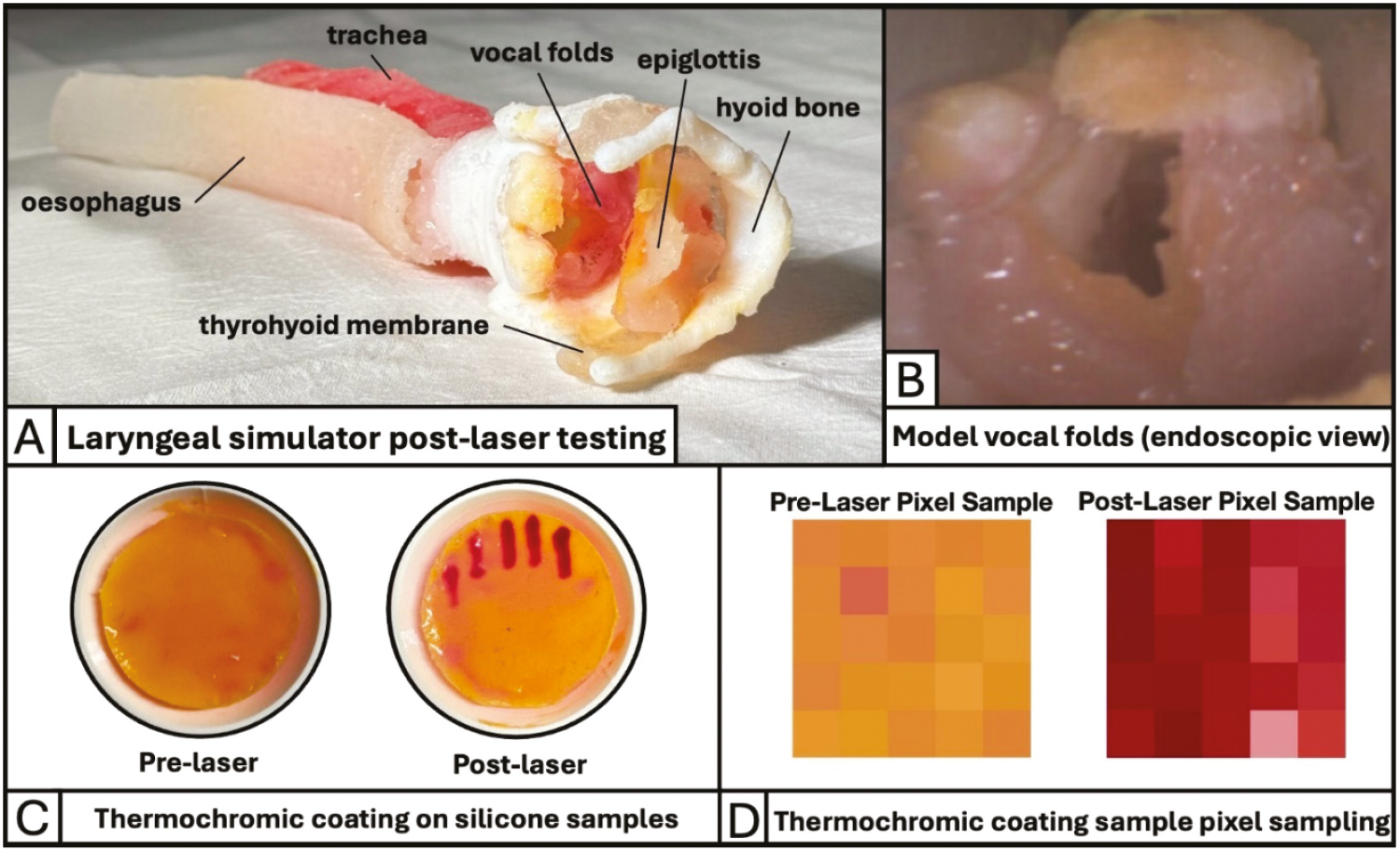
Growing adoption of in-office laryngology procedures emphasises the need for cost-effective and anatomically accurate training models. Blue laser growth removal is one such procedure, requiring precise laser control to remove polyps, papillomas, and cancerous growths <1mm in size [1]. Currently, training methods are limited, using cadavers (high-cost) or the ‘see one, do one, teach one’ method. The aim of this study was to demonstrate the effectiveness of a thermochromic coating for laryngological growth removal training. Through quantitative material testing and practical evaluation on a cost-effective, anatomically accurate, reproducible model, this research aimed to establish a sustainable, patient-safe alternative for training.
Silicone samples with silicone-based thermochromic coating (Figure 1-A125.C) were prepared for blue laser material testing. Colour pixel values were sampled (Figure 1-A125.D) from a high-resolution photograph (13mm, ƒ2.2, ISO 100, 0ev, 12MP), converted into the International Commission on Illumination (CIE) 1976 L*, u*, v* colourspace (CIELUV) and colour difference, delta E (DE) CIEDE2000(1:1:1) was compared to a visual 50:50% acceptability threshold.
The laryngological simulator (Figure 1-A125.A) was constructed using 3-dimensional (3D) printing and moulding. Image segmentation was performed on the computed tomography scans of an adult male to create a 3D model. The model included hyoid bone, thyrohyoid membrane, thyroid cartilage, cricoid cartilage, trachea, oesophagus, epiglottis and vocal folds (Figure 1-A125.B). The bones were 3D printed in a photopolymer and the cartilages in thermoplastic polyurethane. The soft tissues were moulded using silicone rubbers. Following confirmation of sample effectiveness, the thermochromic coating was applied to the vocal folds, epiglottis and surrounding anatomy. Two participants utilised blue laser to test the model and completed a Likert scale questionnaire to evaluate the model’s realism and efficacy for training.


The CIEDE2000 differences (x̄=54.2, σ=9.06) for the silicone samples with thermochromic coating were significantly different from the 50:50% threshold value (p<=0.001) [2].
For the anatomical model, participants rated its usefulness for training highly (x̄=4.0) and its fidelity to human anatomical structures very highly (x̄=5.0).
Significant colour differences from 50:50% threshold value strongly suggest the change in colour from the thermochromic coating is clearly perceptible. The questionnaire responses revealed high satisfaction with the model’s efficacy in blue laser training; this suggests that the simulator, including thermochromic coating can effectively provide immediate feedback on the requisite skills for precise blue laser control in the larynx. The positive responses concerning the model’s accuracy to anatomical structures suggest the realism and robustness of the model.
Authors confirm that all relevant ethical standards for research conduct and dissemination have been met. The submitting author confirms that relevant ethical approval was granted, if applicable
1. Akbari E, Seifpanahi S, Ghorbani A, Izadi F, Torabinezhad F. The effects of size and type of vocal fold polyp on some acoustic voice parameters. IJMS [online]. 2018;43(2):158–163. [Accessed 26 April 2024]. Available from: https://www.ncbi.nlm.nih.gov/pmc/articles/PMC5936847/.
2. Perez Mdel M, Ghinea R, Herrera LJ, Ionescu AM, Pomares H, Pulgar R, et al. Dental ceramics: a CIEDE2000 acceptability thresholds for lightness, chroma and hue differences. Journal of Dentistry [online]. 2011;39(suppl 3):e37–e44. Available from: <doi: 10.1016/j.jdent.2011.09.007>. [Accessed 26 April 2024].